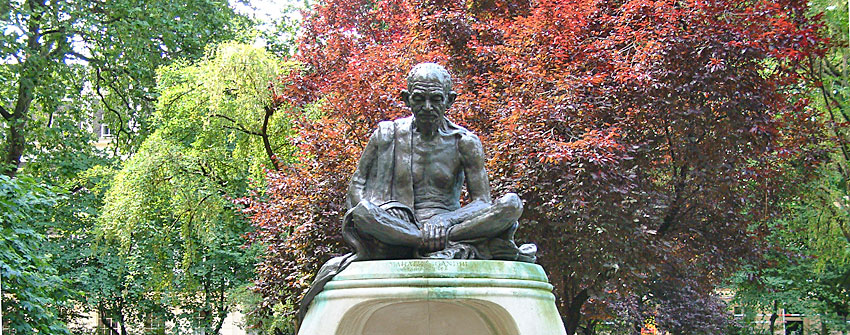 |
MEMORIALS |
GANDHI resist not evil He returned to India in 1891 to work as a lawyer but he was unsuccessful because he was shy, yet unwilling to be pushed about. So in 1893 he took a job in South Africa, representing the interests of Indian merchants. Shortly after reaching South Africa, he experienced its racial prejudice when he was ejected from a first-class railway compartment because a white man objected to him being there, even though Gandhi had a first-class ticket. |
|
||
|
Gandhi joined with his fellow-Indians in working for their rights, and it was in this struggle that he developed the nonviolent techniques he was to use later in India. He opposed unfair taxes levied on Indian workers and he agitated to get Indians their voting rights. In 1904 he set up Phoenix Farm outside Johannesburg, a community where he started to practise simple community living, which he continued at a new community, Tolstoy Farm, five years later. In 1907 he began a campaign against the laws that made Indians register if they wanted to live in South Africa. 3,000 Indians publicly burnt their registration cards. Another great demonstration against racial discrimination took place in 1913, when Gandhi got a contingent of Indian women to march illegally over the border from the Transvaal into the Natal coal fields, where they persuaded the miners to go on strike. When Gandhi and the miners were savagely punished, the outcry made Prime Minister Smuts negotiate with Gandhi, and this resulted in the Indian Relief Act of 1914 which removed some of the burdens from Indians. Gandhi was now convinced of the power of nonviolent disobedience to make people aware of injustices. Gandhi returned to India, an experienced political campaigner. He set up a new community, an 'ashram' at Ahmedabad. People living at the ashram had to be nonviolent and truthful, had to do farming and spinning for their living, and have no servants or personal possessions. At the ashram, women enjoyed full freedom and equal rights, there was complete religious tolerance, and caste distinctions were ignored. salt march When the marchers reached the sea, they started making salt from the sea-water, thus breaking the law. This gesture led to civil disobedience breaking out in many parts of India. 60,000 people were arrested. The second stage of the campaign was to try and take over the salt works at Dharasana. Volunteers marched towards the salt works and, as policemen struck them down with heavy sticks, more volunteers came forward to take their place. Although thousands more arrests were made, the Viceroy decided it was a stalemate and he held talks with Gandhi, which resulted in the Salt Acts being interpreted more humanely and in an agreement that Gandhi could represent his Congress Party at the 1931 Round Table Conference in London. The Conference led nowhere but the salt march gave Indians self-respect and confidence that they could gain independence. India finally became independent in 1947 but Gandhi was unhappy with the settlement because it divided India into two states - India and Pakistan - the first largely for Hindus, the second largely for Muslims. Gandhi did his best to pacify the violence between Hindus and Muslims and his work achieved some success. But in 1948 he was shot and killed by a fellow Hindu who believed Gandhi was betraying the Hindus by working for reconciliation. In the years following independence, the Government led by Nehru (Gandhi's former disciple) ignored Gandhi's schemes for revitalising the villages. Instead they concentrated on industrialisation, which Gandhi saw was not the answer to India's problems. India has a huge population and therefore no shortage of workers; industrialisation only makes unemployment worse by replacing humans with machines. Gandhi's answer lay in India's 500,000 villages, which could be small, self-sufficient, democratic units. grassroots democracy Gandhi 's political and social philosophy has been unjustly neglected. He is better known for his nonviolence or satyagraha, which has been very influential even though it has sometimes been misunderstood. Satyagraha is not simply a strategy for opposing evil without using violence - it is a whole way of reconstructing society, using love and striving for truth. Gandhi said: "To me, Truth is God and there is no way to find Truth except the way of nonviolence". Violence separates people, but the search for truth is a communal enterprise in which we have to work together. Satyagraha uses nonviolent resistance to make one's opponent face up to the fact of injustice or exploitation. However, while satyagrahis use various nonviolent methods to confront or persuade an opponent - methods like sit-downs and sit-ins, strikes, fasts, demonstrations, boycotts, picketing and non-cooperation (all of which Gandhi used) - they should also be doing constructive work to improve the situation. Every time Gandhi started a campaign against some injustice, he also started constructive schemes to improve conditions. Albert Einstein said that Gandhi 's great contribution to our time was his determination to moralise politics. Gandhi insisted that you can apply the same moral values to politics, business or industry as you do in private life. Love, truth, nonviolence - all these ideals can be applied here and now to every aspect of life. "It is perfectly possible," as Gandhi said, "for an individual to adopt this way of life without having to wait for others to do so." |
||||
Peace Pledge Union, 1 Peace Passage, London N7 0BT. Tel +44 (0)20 7424 9444 contact | where to find us
